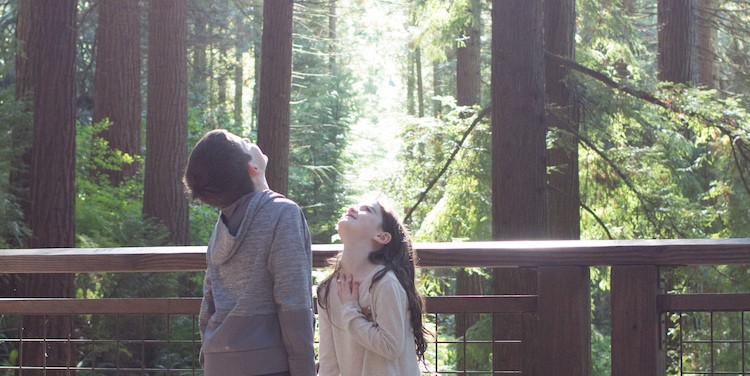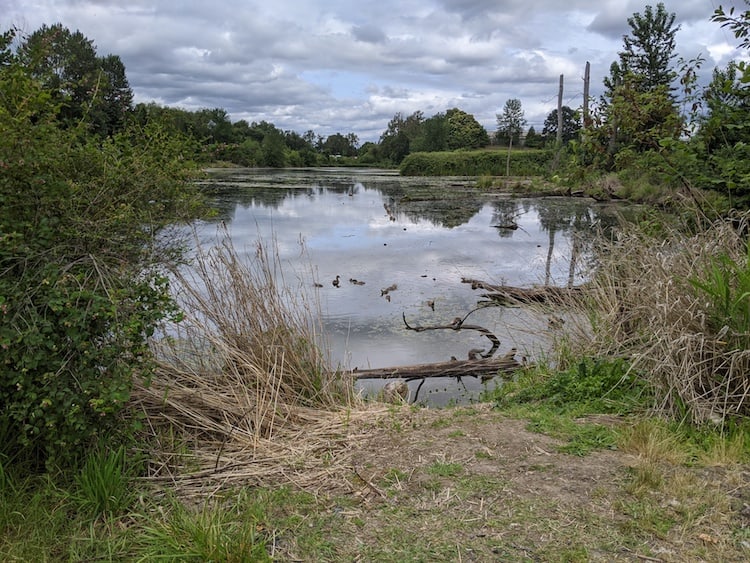
Thanks to Portland Parks & Recreation’s Environmental Education team for this great list of nature parks to check out, plus tips for exploring them with kids.
Each year, Portland Parks & Recreation (PP&R)’s Environmental Education team leads children and adults on nature walks in parks throughout the city. Using common household tools – spoons, cups, magnifying glasses, colored beads, and paintbrushes – the team encourages connection with the natural world through investigation and play.
Check out these Portland parks – slow down and enjoy!
Southwest Portland
HOYT ARBORETUM (both paved and soft surface trails, forests and meadows, picnic shelter)
Ideas for Exploration: More than 2,300 tree species offer interesting and unique habitats for your family to explore. Build fairy houses in the fairy forest along the Spruce trail, play games in the Wedding Meadow along the Fir trail, and stand in awe at the gigantic redwood forest on the Redwood Deck. Other great places to explore this time of year: the Magnolia Trail and the Cherry Trail.
Note: All parking lots in Washington Park, including Hoyt Arboretum, are pay-to-park. Pro-tip: Download the Parking Kitty app before you go.

APRIL HILL PARK (soft surface trails, open grassy space, wetland boardwalk and natural area)
Ideas for Exploration: Bring a soccer ball or frisbee and enjoy an open field for running, jumping, and letting out the wiggles. If you listen close, you’ll also hear an array of birds singing around you. On the southwest corner of the park, follow the trail down into the natural area where a boardwalk over a small creek and wetland lead you into a conifer forest. Keep your eyes and ears open for buzzing insects and critters that hide in the creek.
MARICARA NATURAL AREA (narrow, soft-surface trails, forested, flat hiking)

Ideas for Exploration: Walk slowly through this forested natural area, looking intentionally for signs of decomposition happening all around! Rotting logs and decomposing leaves make incredible habitat for critters that are easily uncovered using an old kitchen spoon. Get an up-close look at beetles, slugs, and worms by bringing along a small mason jar – but make sure to put the creatures back in their homes carefully when you’re done.
Northwest Portland
FOREST PARK – HOLMAN LANE (rugged, soft surface trails, hilly, great for older kids and infant carriers)
Ideas for Exploration: If you’re looking for an option with a longer hiking experience, explore Portland’s largest park from the Holman Lane entrance. Begin by exploring for bugs in the tall grasses of the meadow before climbing the main trail into a dense woodland. Use your deer ears and owl eyes to discover if there any camouflaged creatures hiding in the canopy or shrub layer.
North Portland
KELLEY POINT PARK (both paved and soft surface trails, sand play, open grassy areas)

Ideas for Exploration: Grab a few small containers and a spoon and follow the paved path from the last parking lot down to the waterfront for endless fun in the sand. While you play, notice the large cargo ships passing by, and then hike along one of the trails lined with cottonwood trees and blooming madrone trees. Need to run around? Head into the open grassy spaces with a ball or frisbee. (Please note: Park users are prohibited from entering the water at Kelley Point Park due to unsafe and unpredictable conditions).
PIER PARK (both paved and soft surface trails, gentle hills, lots of shade and large trees, open grassy areas, frisbee golf course, picnic shelter)
Ideas for Exploration: Find an interesting patch of earth to explore on a micro hike by getting down on hands and knees to investigate each inch of ground as if it were a mile long. Bring a piece of string to mark your “trail” and imagine that ants are the size of SUVs and blades of grass are as tall as telephone poles! The grassy fields and big trees are perfect for playing a game of Hide-and-Seek, or a game of link/elbow tag using a tree as the second person (Tree Tag). Listen and look for the trains crossing under the bridge on the west side!
Northeast Portland
WHITAKER PONDS (soft surface trails, wooded, large ponds with water birds, covered gazebo)

Ideas for Exploration: While walking along the Whitaker Ponds loop trail, bring a pair of binoculars and get ready to view an array of bird species. Kingfishers, herons, corvids, hummingbirds, and owls have all been spotted near the pond. Keep your eyes peeled along the North side of the pond for some beaver chews, and head down to the dock with a ladle, an old ice cube tray, and a magnifying glass to explore the world of macro invertebrates.
COLUMBIA CHILDREN’S ARBORETUM (soft surface trails, grassy areas, State trees from across the US, picnic tables)
Ideas for Exploration: Begin your visit by searching through the tall grasses for native Pacific Chorus Frogs before picnicking at tables underneath a blooming magnolia tree at the east end of the park. Try to visit all the state trees in the park and walk the trail through the natural area along the Columbia Slough. Afterwards, open grassy fields await for games, tag, and frisbee.
Southeast Portland
POWELL BUTTE (both paved and soft surface trails, vista point, lots of elevation gain, biking and equestrian trails)
Ideas for Exploration: At this time of year, wildflowers will have just begun to bloom. Use Environmental Education’s bee guide to try and identify local pollinators. Bring some colored pencils and paper and try to sketch some of the plants and animals. Which Cascade peaks can you see from the top of the Mountain View trail? If you have a pair of binoculars, you might spot some colorful birds flitting about the trees and grass.
MT. TABOR PARK (both paved and soft surface trails, picnic shelter, elevation gain, geologic history, viewpoints)

Ideas for Exploration: No matter the season, Mt. Tabor Park offers an amazing opportunity to learn about the geology of the Pacific Northwest. Begin by investigating the lava rock wall of an extinct volcano in the caldera near the main parking lot. After examining this porous, black basalt, explore other trails throughout the park to see if you can find smooth, rounded rocks left behind by the Missoula Floods. (Here’s a hint – head to the top using the stairs on the north side or visit the blooming Star Magnolia trees near Reservoir #5).
WESTMORELAND PARK (meandering boardwalk, creek, waterfowl, natural playground)

Ideas for Exploration: Investigate one of Portland’s biggest habitat restoration successes! More than 15,000 native plants were planted along a half mile of new boardwalk, offering an opportunity to see fuzzy ducklings, buzzing insects, and other Northwest waterfowl. You might even spot a nutria! Finish your exploration at the park’s recently completed nature playground.
- August 2024 Digital Issue - July 26, 2024
- 25 Free Things to Do With the Family in August - July 26, 2024
- Our Favorite Free and Splurgy Summer Date Night Ideas - July 20, 2024






